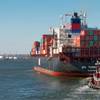Well-known in the shipbuilding industry as a quality builder of various vessels and as a specialist in ship and barge repair, conversions and barge flaring, Lockport, La.-based Bollinger Shipyards has made a name for itself as a major builder of barges used on inland waterways and ocean-going uses. Stemming from the shipyard's growth are five contracts for 17 specialized large barges ranging in sizes from 240 to 365 ft. (73.1 x 111.2 m) Some were recently delivered, while others will be sent off before year-end 2000.
According to Lynn Falgout, vice president and general manager of Bollinger Marine Fabricators, "Until April 1997, we had had a limited barge program in eight shipyards. We upgraded our capacity that year when we acquired the former McDermott shipyard in Amelia, La., which is a 67-acre dedicated barge building facility with large, covered construction buildings. It is now known as Bollinger Marine Fabricators, LLC. It, along with $2 million capital improvement program, has given us the capacity to launch as many as three hopper barges per week as demonstrated with our recently completed MEMCO contract."
"At the time of purchase," Falgout added, "McDermott had a contract for, but had not yet begun construction of 250, 200 x 35 x 13 ft. (60 x 10.6 x 3.9 m) and 14 box and rake hopper barges for MEMCO located in St. Louis, Mo. We began building those barges in April 1996, and completed that contract ahead of schedule in March 1999."
The largest of the contracts amounts to six barges designed by Shearer & Associates, Metairie, La. Measuring 260 x 60 x 14 ft. (79.2 x 18.2 x 42.6 m), the vessels were built for the PCS Phosphate Company located in Raleigh, N.C. Two of the barges will be covered hopper barges built to carry phosphate rock or fertilizer between PCS Phosphate's Aurora, N.C. mine and plant and the port at Morehead City, N.C. Each will be equipped to transport 3,000 metric tons of products and will house fiberglass, telescoping rolling covers.
Designed to carry sulfuric or phosphoric acid, two are 12,000 BBL double skin tank barges with two integral stainless steel cargo tanks equipped with two electric-driven deepwell turbine pumps. Cargo systems valves will be flanged gate valves specifically designed and manufactured for acid service, while all cargo tanks will have a remote read-out level sensor, and sight glass and fittings for future installation of a vapor control system.
The final two of the six-part barge contract calls for double skin barges built to carry molten sulfur. The same size as the bulk cargo and sulfuric acid barges, this pair will have two integral mild steel cargo tanks of 12,000 BBL total capacity. Most equipment present on the other four barges will be duplicated on this pair as well including two electric-driven deepwell turbine pumps and remote read-out level sensors.
Similar to their sulfuric acid sisterbarges - they too will comply with U.S. Coast Guard regulations for Hull Type II. Cargo will be heated with hot oil circulating through four sets of coils in each cargo tank, coiled and arranged that the loss of one set of coils will not detract from the overall heating ability of the system. Hot oil will heat the cargo pumps, fill lines, vents and drip pan drains, while above deck cargo piping and the drip pans will be heated with steam supplied from external sources. A heat exchanger will transfer heat from the shore-supplied steam to hot oil. The cargo heating system, which was designed by Shearer and PCS, provides a quality heating system with due consideration for the type of cargo and the environment where the barges will work.
A self-contained fiberglass house complete with lights, and air conditioning and heating will function as a shelter for crewmembers during the barges' transfer operations.
All six barges will be fitted with 40-ton manual winches and will have identical semi-integrated hull configurations from the main deck down - all will have coatings specially designed for operation in salt water. External hull scantlings based on two PCS barges constructed in 1992 will be present on the six vessels as well. All external and internal welding will be double continuous to strengthen the structural integrity of the hull scantlings and to provide better coating surfaces.
Falgout reports that contracts completed this year at Bollinger Marine Fabricators include two 240 x 60 x 16 ft. (73.1 x 18.2 x 4.8 m) deck barges for Connolly-Pacific Company, Long Beach, Calif.; and four 250 x 52 x 14 ft. (76.2 x 15.8 x 4.2 m) double hull, jumbo hopper barges for Tide Leasing LLC, Birmingham, Ala. The barges built for Connolly-Pacific have 2,900 lbs. per sq. ft. deck loading and were delivered ahead of schedule on September 8. The Tide Leasing hoppers were constructed with .75-in. steel at the bottom and .625-in. steel at the sides. In separate tandem tows, all arrived at their South American destination of Santa Maria, Colombia during September and October.
Bollinger's additional projects currently in the works include: two double skin 356 x 54 x 13 ft. (108.5 x 16.4 x 3.9 m) asphalt tank barges for American General Transportation, Mobile, Ala.; one 295 x 52.5 x 14 ft. (89.9 x 16 x 42.6 m) cement barge for Indianapolis-based Lone Star Industries measuring 295 x 52.5 x 14 ft. (89.9 x 16 x 4.2 m); and two 240 x 54 x 22 ft. (73.1 x 16.4 x 6.7 m) 4,000 cubic yard split hull dump scows for DonJon Marine Company in Hillside, N.J.
Sponsored Content
Achieve Smarter Safety and Compliance with ABS Wavesight

March 2025
 Read the Magazine
Read the Magazine

 Read the Magazine
Read the Magazine
This issue sponsored by:

TEST RIDE: Rock Steady - The Artemis EF-12 Escape
Subscribe for
Maritime Reporter E-News
Maritime Reporter E-News is the maritime industry's largest circulation and most authoritative ENews Service, delivered to your Email five times per week










